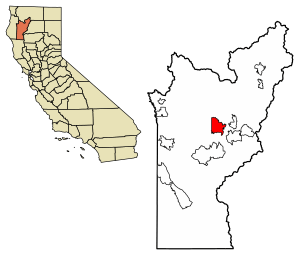Junction City, California facts for kids
Quick facts for kids
Junction City
|
|
|---|---|

Location of Junction City in Trinity County, California.
|
|
| Country | |
| State | |
| County | Trinity |
| Area | |
| • Total | 27.949 sq mi (72.388 km2) |
| • Land | 27.904 sq mi (72.272 km2) |
| • Water | 0.045 sq mi (0.116 km2) 0.16% |
| Elevation | 1,909 ft (582 m) |
| Population
(2020)
|
|
| • Total | 658 |
| • Density | 23.543/sq mi (9.090/km2) |
| Time zone | UTC-8 (Pacific (PST)) |
| • Summer (DST) | UTC-7 (PDT) |
| ZIP Code |
96048
|
| Area code(s) | 530 |
| GNIS feature ID | 2583043 |
Junction City is a small community in Trinity County, California. It's known as a census-designated place (CDP), which means it's a special area defined by the government for counting people. Junction City is located about 1,909 feet (582 meters) above sea level. In 2020, about 658 people lived there. This is a small decrease from the 680 people counted in 2010.
Junction City is about 8 miles (13 km) west of Weaverville. The Trinity River flows right through the town. The local mail code, or ZIP Code, is 96048, and the phone area code is 530.
Contents
History of Junction City
Junction City started in the 1850s when people built a few cabins near Canyon Creek. It was first called "Milltown" because there were many mills there. But in 1861, it was officially named Junction City. This was because it was a meeting point for different travel routes along Canyon Creek and the Trinity River.
The town was home to a very important dam called the Arkansas Dam. It was built in 1851, about four miles upstream from Junction City. This dam helped control water for mining. It was rebuilt strongly after being washed out by floods in 1851 and 1852. However, in 1857, miners took the dam apart to get to the gold hidden underneath it.
In 1988, a special place called Rigdzin Ling was built in Junction City. It is a Tibetan Buddhist temple and part of the Chagdud Gonpa Foundation.
In May 2005, the old hotel in Junction City burned down. It was one of the last buildings from the 1800s left in the town.
Junction City has also faced large wildfires. In May 2006, the Junction Fire burned about 3,500 acres (14 km²). This fire later joined with another fire, the Bar Fire, and together they burned over 100,000 acres (400 km²). The Junction Fire put Junction City and parts of Weaverville at risk. On July 20, 2008, more fires threatened the area, causing some people to leave their homes. These fires started after a big lightning storm in Northern California.
Education
The public schools in Junction City are managed by the Junction City Elementary School District. This district has one elementary school for students from kindergarten to 8th grade. The school year usually starts in late August or early September and ends in June.
- Junction City Elementary School [1]
Geography
Junction City covers an area of about 27.9 square miles (72.4 km²). Most of this area, about 99.84%, is land. The rest, about 0.16%, is water.
Transportation
Major Highways
 State Route 299 is a main road that goes through the middle of Junction City. The part of State Route 299 between Arcata and Redding is called the Trinity Scenic Byway. This means it's a special road known for its beautiful views and natural scenery.
State Route 299 is a main road that goes through the middle of Junction City. The part of State Route 299 between Arcata and Redding is called the Trinity Scenic Byway. This means it's a special road known for its beautiful views and natural scenery.
Parks and Trails
- Junction City Park
Population and People
Junction City's population has changed over the years. Here's how many people have lived there during different census counts:
| Historical population | |||
|---|---|---|---|
| Census | Pop. | %± | |
| 1870 | 440 | — | |
| 2000 | 620 | — | |
| 2010 | 680 | 9.7% | |
| 2020 | 658 | −3.2% | |
| U.S. Decennial Census 1850–1870 1880-1890 1900 1910 1920 1930 1940 1950 1960 1970 1980 1990 2000 2010 |
|||
2010 Census Information
In 2010, the population of Junction City was 680 people. Most of the people, about 96.9%, lived in regular homes. The average number of people in each home was about 2.25. The median age in Junction City was 52.3 years old. This means half the people were younger than 52.3 and half were older.
Historical Markers
There is a special historical marker in Junction City. It was placed there to celebrate the town's 100th birthday. You can find it next to the Junction City store. [2]
See also
 In Spanish: Junction City (California) para niños
In Spanish: Junction City (California) para niños


